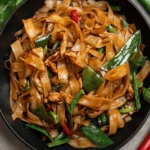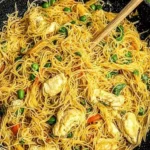Homemade gnocchi is a comforting dish that’s as satisfying to make as it is to eat. With its soft, pillowy texture, this gnocchi is perfect when paired with a simple tomato sauce or a rich, creamy pesto. The process of rolling and cutting the dough into little pillows adds a personal touch, making each bite feel homemade and special.
Whether you’re serving it for a cozy dinner at home or as part of a larger Italian feast, these gnocchi are bound to impress. The light and fluffy texture will melt in your mouth, offering a perfect balance to any flavorful sauce or topping you choose. Plus, this recipe is simple enough for anyone to master, making it a great introduction to the world of homemade pasta.
Full Recipe:
-
2 lbs russet potatoes
-
1 egg
-
2 cups all-purpose flour
-
1/2 teaspoon salt
-
A pinch of nutmeg (optional)
Directions:
-
Peel and chop the potatoes. Boil them in salted water until tender, about 20 minutes. Drain and mash the potatoes until smooth.
-
Allow the mashed potatoes to cool slightly before adding the egg, flour, salt, and nutmeg.
-
Gently combine the ingredients into a dough, adding more flour if necessary to keep it from being too sticky.
-
Divide the dough into portions, rolling each into long ropes about 1/2 inch thick.
-
Cut the ropes into 1-inch pieces, and use a fork to create indentations in each piece.
-
Bring a pot of salted water to a boil. Drop the gnocchi in batches into the water, cooking until they float to the surface, about 2-3 minutes.
-
Remove the gnocchi with a slotted spoon and set aside.
-
Optional: sauté the cooked gnocchi in a little butter or olive oil for a crispy exterior, if desired.
Prep Time: 20 minutes | Cooking Time: 30 minutes | Total Time: 50 minutes
Kcal: 220 kcal | Servings: 4 servings
History and Origin
Gnocchi, the plural of “gnocco,” which translates to “lump” or “knot,” has roots in Italy that date back to ancient times. Originally, gnocchi was made from bread and flour, and as potatoes became widely available in Europe in the 18th century, they quickly became a key ingredient in the dish. The first records of potato-based gnocchi come from northern Italy, particularly the regions of Lombardy, Piemonte, and Veneto, where the cooler climate made potatoes a staple food.
Over the centuries, gnocchi has evolved from its humble origins into a beloved Italian comfort food that transcends regional borders. It’s served in different forms across Italy, with each region adding its own twist, whether by incorporating different flours, vegetables, or cheeses into the dough.
Today, gnocchi is enjoyed not just in Italy, but around the world, with families and chefs alike experimenting with different variations. It is especially popular in Italian-American cuisine, where it’s often paired with rich tomato sauce and melted cheese, though in Italy, it’s typically served with more refined, delicate sauces.
Variations and Adaptations
While the classic potato gnocchi recipe is the most well-known, there are countless regional variations across Italy, each adding a unique flair to this beloved dish.
-
Ricotta Gnocchi: In some parts of Italy, particularly in the southern regions, ricotta cheese is used in place of potatoes, creating a lighter, fluffier texture. Ricotta gnocchi are often paired with simple tomato sauces or a drizzle of olive oil and fresh herbs.
-
Spinach Gnocchi (Gnocchi alla Romana): This variation replaces some of the potato with cooked spinach, giving the gnocchi a vibrant green color and an earthy flavor. In some cases, semolina flour is also used, giving the gnocchi a firmer texture.
-
Pumpkin Gnocchi: Fall in Italy calls for the use of seasonal vegetables, and pumpkin gnocchi is a favorite in northern Italy. The sweetness of the pumpkin pairs beautifully with sage butter or a brown butter sauce.
-
Sweet Potato Gnocchi: A popular variation in both the United States and Italy, sweet potato gnocchi adds a rich sweetness to the dough, making it an ideal match for savory, spicy sauces or even maple syrup for a more decadent twist.
Each region has a unique approach, using locally available ingredients to shape the gnocchi to their tastes. Regardless of the variation, the method of preparation—rolling, cutting, and cooking the gnocchi in boiling water—remains consistent across the board.
Nutritional Information
While gnocchi is undeniably delicious, it’s important to understand its nutritional profile. Here’s a breakdown of what you can expect from homemade potato gnocchi:
-
Calories: Homemade gnocchi contains around 220 calories per serving, depending on the amount of flour used. The potato provides the bulk of the calories, while the egg helps bind the dough and adds protein.
-
Carbohydrates: The gnocchi is rich in carbohydrates, providing around 45 grams of carbs per serving. This is mostly from the potatoes, which are a great source of energy. However, for those monitoring their carbohydrate intake, portion control is key.
-
Protein: A serving of gnocchi contains about 4-5 grams of protein, mainly from the egg. It’s not a high-protein food, but it provides a small amount to balance the carbs.
-
Fat: The fat content in gnocchi is relatively low, but it can increase significantly if you sauté the gnocchi in butter or oil after boiling them.
-
Vitamins and Minerals: Potatoes are a good source of vitamin C, potassium, and B vitamins, including B6. However, the micronutrient content of gnocchi largely depends on any additional ingredients or sauces you pair with it.
While gnocchi is not a low-calorie or low-carb food, it offers a satisfying meal that can be enjoyed in moderation as part of a balanced diet. Adding vegetables or lean proteins can enhance the dish’s nutritional value and make it a more well-rounded meal.
Serving Suggestions and Pairings
Homemade gnocchi is versatile and can be paired with a variety of sauces and accompaniments, depending on your mood or the season. Here are a few creative ways to serve this dish:
-
Classic Marinara Sauce: The tangy acidity of tomato sauce balances the rich, soft gnocchi perfectly. Top with fresh basil and a generous sprinkle of Parmesan cheese for a simple, flavorful dish.
-
Brown Butter and Sage: For a more sophisticated touch, sauté the gnocchi in brown butter and fresh sage leaves. The nutty flavor of the butter enhances the pillowy gnocchi, creating a melt-in-your-mouth experience.
-
Pesto Sauce: Fresh basil pesto is an excellent choice for gnocchi, especially when paired with grilled chicken or vegetables. The vibrant green pesto contrasts beautifully with the soft dumplings.
-
Creamy Mushroom Sauce: A rich, earthy mushroom sauce made with garlic, shallots, and cream pairs wonderfully with gnocchi, adding depth and complexity to the dish.
-
Wine Pairings: For a lighter option, serve gnocchi with a crisp, dry white wine like a Pinot Grigio or Sauvignon Blanc. If you prefer red wine, a light-bodied Chianti or Barbera will complement the flavors of the gnocchi.
-
For a complete meal: Serve gnocchi alongside a simple salad with arugula, cherry tomatoes, and a balsamic vinaigrette for a refreshing contrast to the rich, comforting gnocchi.
Tips and Tricks for Success
Making homemade gnocchi can seem like a daunting task, but with a few expert tips, you’ll be rolling out perfect gnocchi every time:
-
Use starchy potatoes: Russet potatoes are ideal for gnocchi because they are starchy and dry, which helps the dough hold together. Avoid waxy potatoes like red potatoes, as they can make the gnocchi too dense and sticky.
-
Don’t overwork the dough: When mixing the dough, be gentle. Overworking the dough can lead to tough gnocchi. Once the dough comes together, it’s ready to be rolled and cut.
-
Test a dumpling before boiling: Before boiling the entire batch, cook one gnocchi to test the dough. If it falls apart in the water, add a little more flour to the dough.
-
Flour the surface liberally: When rolling out the dough, make sure the surface is well-floured to prevent sticking. But be careful not to add too much flour to the dough, as it can make the gnocchi heavy.
-
Freeze for later: Homemade gnocchi can be frozen before cooking. Lay the gnocchi out on a baking sheet and freeze them in a single layer before transferring to a freezer bag. You can cook them directly from the freezer when you’re ready to enjoy them.
Potential Health Benefits
While gnocchi is generally considered a rich comfort food, its ingredients—potatoes, eggs, and flour—can provide some health benefits when consumed in moderation.
-
Potatoes are a good source of fiber, potassium, and vitamin C, which helps support immune health, lower blood pressure, and improve digestion.
-
Eggs contribute high-quality protein, helping to build and repair tissues in the body.
-
Flour provides carbohydrates, which are a primary source of energy for the body.
Pairing gnocchi with a healthy sauce, such as a vegetable-based marinara or a creamy mushroom sauce, can increase its nutritional value by adding antioxidants, vitamins, and minerals.
Conclusion
Homemade gnocchi is a timeless dish that brings the taste of Italy into your kitchen. With a simple yet versatile base, it can be paired with a wide range of sauces and accompaniments to suit any taste. Whether you’re making it for a weeknight dinner or a special occasion, homemade gnocchi never fails to impress. Take your time, follow the tips, and savor every bite of this comforting, delicious dish.
This recipe will surely become a staple in your cooking repertoire. So, grab your potatoes and flour, roll up your sleeves, and get ready to enjoy the simple pleasure of homemade gnocchi!





